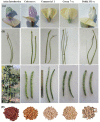Estimates of genotypic and phenotypic variance, heritability, and genetic advance of horticultural traits in developed crosses of cowpea (Vigna unguiculata [L.] Walp)
- PMID: 36237497
- PMCID: PMC9551400
- DOI: 10.3389/fpls.2022.987985
Estimates of genotypic and phenotypic variance, heritability, and genetic advance of horticultural traits in developed crosses of cowpea (Vigna unguiculata [L.] Walp)
Abstract
Cowpea, in addition to being a food and feed crop, plays a key role in sustainable farming. The present study's goal is to develop new high-yielding cowpea varieties. A Field experiment was carried out across 3 summer seasons and the breeding program included 28 distinct cowpea varieties, out of which five potential parents were selected for this investigation. Local cultivars, i.e., Cream 7 'Cr7', Dokki 331 'D331', Commercial 1 'Com1', and introduced cultivars, i.e., Colossus 'Col' and Asian Introduction 'AI' were utilized to produce six crosses in two generations apart; F1 and F2: Col x AI, Col x Com1, Cr7 x AI, Cr7 x Com1, D331 x AI, and D331 x Com1. 'AI' and 'Com1' were superior in pod length, pod diameter, number of seeds/pod and seeds weight/pod, whereas 'Col', 'Cr7' and 'D331' were superior in seeds yield/plant, number of pods/plant and the least number of aborted ovules/pod. The genotypes/crosses showed greater genotypic variance (GV) than phenotypic variance (PV) for number of pods/plant, pod length, number of seeds/pod, number of aborted ovules/pod, fresh pod weight, seeds weight/pod, and seeds yield/plant. All studied variables showed high heritability (H%) in genotypes/crosses, despite the exception of seeds weight/pod, which ranged from 29.14 in 'D331' to 83.7 in F2 of Col x Com1. F2 plants and their parents' genotypes showed greater H%. Cr7 x AI developed the most H%, 99.04% for number of pods/plant. D331 x Com1 and Cr7 x AI exhibited moderate H% for fresh pod weight in F1, but all other crosses had high H%. F1 and F2 crosses yielded moderate to high GCV and PCV for number of seeds/pod. Variations in parental genotypes and crossings reflect genetic diversity and the possibility of selection. Crossing with 'AI,' and 'Com1' genotypes enhanced the performance of the other varieties, 'Col', 'D331' and 'Cr7'. Cr7 x Com1 and D331 x AI were selected as the most promising crosses for cowpea breeding programs.
Keywords: cowpea (Vigna unguiculata L. Walp.); cowpea crosses; genotypic variance; heritability; phenotypic variance; pod traits; yield and yield components.
Copyright © 2022 Zaki and Radwan.
Conflict of interest statement
The authors declare that the research was conducted in the absence of any commercial or financial relationships that could be construed as a potential conflict of interest.
Figures



Similar articles
-
Assessing the genetic diversity of cowpea [Vigna unguiculata (L.) Walp.] germplasm collections using phenotypic traits and SNP markers.BMC Genet. 2020 Sep 18;21(1):110. doi: 10.1186/s12863-020-00914-7. BMC Genet. 2020. PMID: 32948123 Free PMC article.
-
Diallel Analysis and Heritability of Grain Yield, Yield Components, and Maturity Traits in Cowpea (Vigna unguiculata (L.) Walp.).ScientificWorldJournal. 2020 Aug 1;2020:9390287. doi: 10.1155/2020/9390287. eCollection 2020. ScientificWorldJournal. 2020. PMID: 32802007 Free PMC article.
-
Genetic variability, heritability and correlation analysis among maturity and yield traits in Cowpea (Vigna unguiculata (L) Walp) in Northern Ghana.Heliyon. 2021 Aug 28;7(9):e07890. doi: 10.1016/j.heliyon.2021.e07890. eCollection 2021 Sep. Heliyon. 2021. PMID: 34522801 Free PMC article.
-
Introgression Breeding in Cowpea [Vigna unguiculata (L.) Walp.].Front Plant Sci. 2020 Sep 16;11:567425. doi: 10.3389/fpls.2020.567425. eCollection 2020. Front Plant Sci. 2020. PMID: 33072144 Free PMC article. Review.
-
Cowpea Constraints and Breeding in Europe.Plants (Basel). 2023 Mar 16;12(6):1339. doi: 10.3390/plants12061339. Plants (Basel). 2023. PMID: 36987026 Free PMC article. Review.
Cited by
-
Bioreactor Systems to Mass-Produce the Undervalued Crop, Celosia argentea, With High Nutrient Impact.Eng Life Sci. 2025 Aug 13;25(8):e70038. doi: 10.1002/elsc.70038. eCollection 2025 Aug. Eng Life Sci. 2025. PMID: 40814569 Free PMC article.
-
An Integrated Multi-Omics and Artificial Intelligence Framework for Advance Plant Phenotyping in Horticulture.Biology (Basel). 2023 Sep 30;12(10):1298. doi: 10.3390/biology12101298. Biology (Basel). 2023. PMID: 37887008 Free PMC article. Review.
-
Quantitative Trait Loci Mapping for Yield and Related Traits in Cowpea.Genes (Basel). 2025 Feb 21;16(3):247. doi: 10.3390/genes16030247. Genes (Basel). 2025. PMID: 40149399 Free PMC article.
-
Exploring the phenotypic diversity of Eragrostis tef for biomass and grain production under optimum growth conditions.Front Plant Sci. 2025 Mar 17;16:1538510. doi: 10.3389/fpls.2025.1538510. eCollection 2025. Front Plant Sci. 2025. PMID: 40166726 Free PMC article.
References
-
- Adewale B. D., Adeigbe O. O., Aremu C. O. (2011). Genetic distance and diversity among some cowpea (Vigna unguiculata l. walp) genotypes. Int. J. Res. Plant Sci. 1 (2), 9–14. doi: 10.1155/2016/8956412 - DOI
-
- Ajayi A. T., Adekola M. O., Taiwo B. H., Azuh V. O. (2014. a). Character expression and differences in yield potential of ten genotypes of cowpea (Vigna unguiculata l. Walp). Int. J. Plant Res. 4 (3), 63–71. doi: 10.5923/j.plant.20140403.01 - DOI
-
- Ajayi A. T., Osekita O. S., Osaghae S. O. (2014. b). Variability among some accessions of cowpea (Vigna unguiculata l. walp) in Nigeria on the expression of quantitative traits. FUTA. J. Res. Sci. 1), 26–34. doi: 10.5923/j.plant.20140403.01 - DOI
-
- Allen O. N., Allen E. K. (1981). The leguminosae: a source book of characteristics, uses and nodulation (Madison: The University of Wisconsin Press; ).
-
- Animasaun D. A., Oyedeji S., Azeez Y. K., Mustapha O. T., Azeez M. A. (2015). Genetic variability study among ten cultivars of cowpea (Vigna unguiculata l walp) using morpho-agronomic traits and nutritional composition. J. Agric. Sci. 10, 119–130. doi: 10.4038/jas.v10i2.8057 - DOI
LinkOut - more resources
Full Text Sources
Miscellaneous

